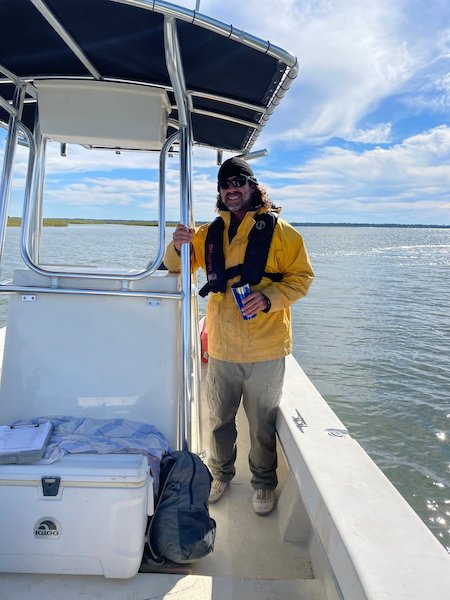USCB's Dr. Eric Montie Featured in Eco Video
 Dr. Eric Montie, PhD, Associate Professor of Biology in the Department of Natural
Sciences at USCB, is Director of the Marine Sensory and Neurobiology Lab and The Lowcountry
Dolphin Conservation Program.
Dr. Eric Montie, PhD, Associate Professor of Biology in the Department of Natural
Sciences at USCB, is Director of the Marine Sensory and Neurobiology Lab and The Lowcountry
Dolphin Conservation Program.USCB’s Dr. Eric Montie and his dolphin research are featured in a new video produced by the Port Royal Sound Foundation. In it, Montie explains what he does, why he loves it and why his research is important.
In the film, viewers accompany Dr. Eric Montie and his lab assistant Alyssa Marian on a dolphin survey trip on the May River in Bluffton, SC. As they make their way by boat from the mouth of the river to its headwaters near Palmetto Bluff, they count the number of dolphins they see, photograph them and identify individual dolphins by the unique markings on their dorsal fins. After years of research, the scientists are able to distinguish between resident and migrating dolphins.
Keeping tabs on the dolphin population through surveys is important because dolphins are apex predators.
“The more dolphins we have in an estuary, most likely the healthier the estuary —meaning that there’s more prey that these animals can feed on,” Montie said.
His research includes collecting recordings of estuary soundscapes from nine recorders placed in four different estuaries throughout South Carolina. The devices are listening to snapping shrimp and fish species such as black drum, red drum and spotted sea trout. The recorders also pick up the sounds that bottlenose dolphins make.
Montie, Marian and some of Montie’s advanced undergraduate students study the recordings to learn more about the relationships between prey and predator. The recorders also pick up other noises such as boat activity. These soundscape recordings are especially useful to scientists working in areas where visibility is limited, such as Bluffton’s May River.
“Dolphins sort of act as canaries in the coal mines,” Montie says in the video. “If the system isn’t doing well, their populations may drop.
Montie is an Associate Professor of Biology in USCB’s Department of Natural Sciences. He is director of the University’s Marine Sensory & Neurobiology Lab.
Port Royal Sound Foundation Executive Director Jody Hayward said the non-profit organization produced the video as a tool for educating the community about the local environment, promoting STEAM careers, and preserving the Port Royal Sound.
“A special thank you to Eric Montie and Alyssa Marian for offering their time and expertise, and to PRSF’s Kat Armstrong and Harden Creative for putting this production together,” she said.
Watch the video: https://www.youtube.com/watch?v=wEyhcoql0Ss